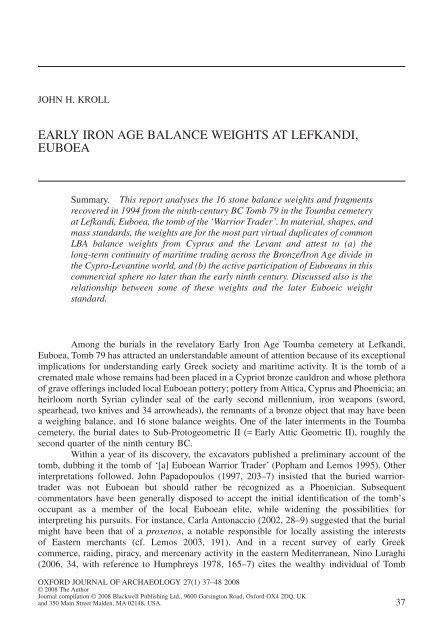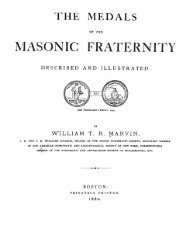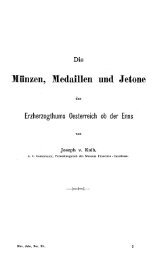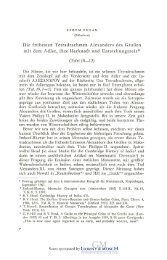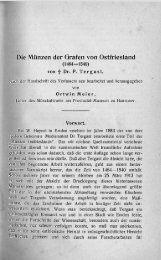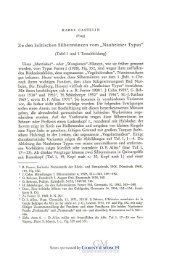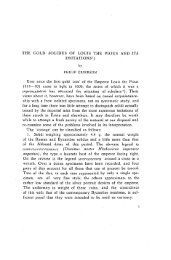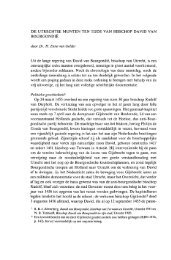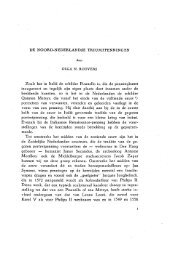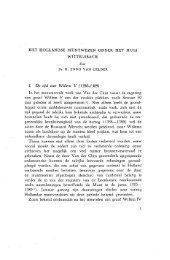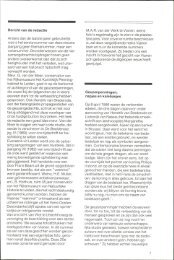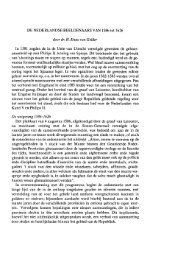Early Iron Age balance weights at Lefkandi, Euboea
Early Iron Age balance weights at Lefkandi, Euboea
Early Iron Age balance weights at Lefkandi, Euboea
You also want an ePaper? Increase the reach of your titles
YUMPU automatically turns print PDFs into web optimized ePapers that Google loves.
JOHN H. KROLL<br />
EARLY IRON AGE BALANCE WEIGHTS AT LEFKANDI,<br />
EUBOEA<br />
Summary. This report analyses the 16 stone <strong>balance</strong> <strong>weights</strong> and fragments<br />
recovered in 1994 from the ninth-century BC Tomb 79 in the Toumba cemetery<br />
<strong>at</strong> <strong>Lefkandi</strong>, <strong>Euboea</strong>, the tomb of the ‘Warrior Trader’. In m<strong>at</strong>erial, shapes, and<br />
mass standards, the <strong>weights</strong> are for the most part virtual duplic<strong>at</strong>es of common<br />
LBA <strong>balance</strong> <strong>weights</strong> from Cyprus and the Levant and <strong>at</strong>test to (a) the<br />
long-term continuity of maritime trading across the Bronze/<strong>Iron</strong> <strong>Age</strong> divide in<br />
the Cypro-Levantine world, and (b) the active particip<strong>at</strong>ion of <strong>Euboea</strong>ns in this<br />
commercial sphere no l<strong>at</strong>er than the early ninth century. Discussed also is the<br />
rel<strong>at</strong>ionship between some of these <strong>weights</strong> and the l<strong>at</strong>er Euboeic weight<br />
standard.<br />
Among the burials in the revel<strong>at</strong>ory <strong>Early</strong> <strong>Iron</strong> <strong>Age</strong> Toumba cemetery <strong>at</strong> <strong>Lefkandi</strong>,<br />
<strong>Euboea</strong>, Tomb 79 has <strong>at</strong>tracted an understandable amount of <strong>at</strong>tention because of its exceptional<br />
implic<strong>at</strong>ions for understanding early Greek society and maritime activity. It is the tomb of a<br />
crem<strong>at</strong>ed male whose remains had been placed in a Cypriot bronze cauldron and whose plethora<br />
of grave offerings included local <strong>Euboea</strong>n pottery; pottery from Attica, Cyprus and Phoenicia; an<br />
heirloom north Syrian cylinder seal of the early second millennium, iron weapons (sword,<br />
spearhead, two knives and 34 arrowheads), the remnants of a bronze object th<strong>at</strong> may have been<br />
a weighing <strong>balance</strong>, and 16 stone <strong>balance</strong> <strong>weights</strong>. One of the l<strong>at</strong>er interments in the Toumba<br />
cemetery, the burial d<strong>at</strong>es to Sub-Protogeometric II (= <strong>Early</strong> Attic Geometric II), roughly the<br />
second quarter of the ninth century BC.<br />
Within a year of its discovery, the excav<strong>at</strong>ors published a preliminary account of the<br />
tomb, dubbing it the tomb of ‘[a] <strong>Euboea</strong>n Warrior Trader’ (Popham and Lemos 1995). Other<br />
interpret<strong>at</strong>ions followed. John Papadopoulos (1997, 203–7) insisted th<strong>at</strong> the buried warriortrader<br />
was not <strong>Euboea</strong>n but should r<strong>at</strong>her be recognized as a Phoenician. Subsequent<br />
comment<strong>at</strong>ors have been generally disposed to accept the initial identific<strong>at</strong>ion of the tomb’s<br />
occupant as a member of the local <strong>Euboea</strong>n elite, while widening the possibilities for<br />
interpreting his pursuits. For instance, Carla Antonaccio (2002, 28–9) suggested th<strong>at</strong> the burial<br />
might have been th<strong>at</strong> of a proxenos, a notable responsible for locally assisting the interests<br />
of Eastern merchants (cf. Lemos 2003, 191). And in a recent survey of early Greek<br />
commerce, raiding, piracy, and mercenary activity in the eastern Mediterranean, Nino Luraghi<br />
(2006, 34, with reference to Humphreys 1978, 165–7) cites the wealthy individual of Tomb<br />
OXFORD JOURNAL OF ARCHAEOLOGY 27(1) 37–48 2008<br />
© 2008 The Author<br />
Journal compil<strong>at</strong>ion © 2008 Blackwell Publishing Ltd., 9600 Garsington Road, Oxford OX4 2DQ, UK<br />
and 350 Main Street Malden, MA 02148, USA. 37
EARLY IRON AGE BALANCE WEIGHTS AT LEFKANDI, EUBOEA<br />
79 as fitting the profile of early Greek pir<strong>at</strong>e-traders, adventurers who with their ships and<br />
men opportunistically sought their fortunes overseas by violence as well as by peaceful<br />
means. 1<br />
The presence of <strong>balance</strong> <strong>weights</strong> was fundamental to all of these interpret<strong>at</strong>ions. Yet,<br />
although Mervyn Popham and Irene Lemos (1996, 204, pl. 149) published the masses of the 13<br />
complete and nearly complete Tomb 79 <strong>weights</strong> along with good photographs in <strong>Lefkandi</strong> III, a<br />
volume of pl<strong>at</strong>es with captions, the <strong>weights</strong> had remained unstudied until now. Generously<br />
encouraged by Dr. Lemos to examine these intriguing artefacts, I here present observ<strong>at</strong>ions on<br />
them and their metrological implic<strong>at</strong>ions in advance of the final public<strong>at</strong>ion of the Toumba<br />
cemetery currently in prepar<strong>at</strong>ion.<br />
analysis and comparanda<br />
A conspectus of the <strong>weights</strong> by shape, condition, mass, mass standard and denomin<strong>at</strong>ion<br />
is provided in Table 1. Figure 1 illustr<strong>at</strong>es the objects <strong>at</strong> actual size. Since the <strong>weights</strong> had<br />
been put on the funeral pyre and burned with the dead man, along with the bronze (?)scale,<br />
his weaponry, the cylinder seal, and some of the vases, nearly all of the <strong>weights</strong> have been<br />
discoloured and fractured by fire. They were then placed in the tomb chamber, except for four of<br />
the smaller ones (1–3, 15) th<strong>at</strong> were excav<strong>at</strong>ed from the filling of the tomb shaft, apparently<br />
having been dropped during removal from pyre to the tomb chamber. From single fragments of<br />
three <strong>weights</strong> (4, 8, and 12) it is clear th<strong>at</strong> other fragments have been lost altogether.<br />
Quite apart from their discovery in a rich assemblage involving other exceptional grave<br />
goods, the Toumba <strong>weights</strong> are a singular find in their own right as they happen to be the only<br />
<strong>balance</strong> <strong>weights</strong> th<strong>at</strong> survive in Aegean Greece from between c.1200 and the sixth century BC.<br />
This is not to say, however, th<strong>at</strong> they lack good comparanda. Similar stone <strong>balance</strong> <strong>weights</strong> from<br />
the eastern Mediterranean have been excav<strong>at</strong>ed and published by the hundreds, although nearly<br />
all of them d<strong>at</strong>e to the L<strong>at</strong>e Bronze <strong>Age</strong> or earlier. So fully do the <strong>Lefkandi</strong> <strong>weights</strong> in all general<br />
respects replic<strong>at</strong>e conventional trade <strong>weights</strong> of the Bronze <strong>Age</strong> Levant and Cyprus th<strong>at</strong> if, for<br />
example, they happened to appear without provenience on the intern<strong>at</strong>ional antiquities market,<br />
they would have been d<strong>at</strong>ed to the fourteenth or thirteenth century, labelled Cypro-Levantine,<br />
and would have stirred little scholarly interest in so far as extant <strong>balance</strong> <strong>weights</strong> from th<strong>at</strong> period<br />
and region are commonplace. Like most of these hundreds of other Bronze <strong>Age</strong> <strong>weights</strong>, the<br />
Toumba <strong>weights</strong> are made of haem<strong>at</strong>ite, a black, iron-bearing stone of exceptional hardness. The<br />
shapes of most of the Toumba <strong>weights</strong> repe<strong>at</strong> popular Bronze <strong>Age</strong> shapes. And the mass or<br />
weight standards to which they are adjusted are, in all measurable cases, weight standards th<strong>at</strong><br />
were commonly employed in the Levant and Cyprus during the second millennium.<br />
In recent decades, understanding of the typology and metrology of LBA <strong>balance</strong><br />
<strong>weights</strong> has been gre<strong>at</strong>ly advanced by the public<strong>at</strong>ion of several major lots: the 566 LBA <strong>weights</strong><br />
excav<strong>at</strong>ed <strong>at</strong> Ras Shamra/Ugarit on the Syrian coast (Courtois 1990); 156 LBA <strong>weights</strong> from<br />
the excav<strong>at</strong>ions <strong>at</strong> Enkomi on Cyprus (Courtois 1984); some smaller assemblages from other<br />
Cypriot sites and cemeteries (cf. Petruso 1984; Lassen 2000); and, especially important, the<br />
well-studied m<strong>at</strong>erial from the two LBA shipwrecks excav<strong>at</strong>ed off the coast of South-West<br />
1 For a parallel characteriz<strong>at</strong>ion of many early Greek (and, in the Odyssey, Phoenician) seafarers as ‘pir<strong>at</strong>es/<br />
merchants engaged in the pir<strong>at</strong>ical, opportunistic model of trade’, see Figueira 1981, 204, with full Homeric<br />
references.<br />
38<br />
OXFORD JOURNAL OF ARCHAEOLOGY<br />
© 2008 The Author<br />
Journal compil<strong>at</strong>ion © 2008 Blackwell Publishing Ltd.
table 1<br />
The Tomb 79 <strong>balance</strong> <strong>weights</strong><br />
Nos. 1 Condition Mass 2 Denomin<strong>at</strong>ion and shekel standard<br />
SPHENDONOID SHAPE<br />
1. (A) fractured but complete 4.1 g 1 /2 (c.8.4 g) shekel (= c.4.2 g)<br />
2. (B) small chip missing 5.9 g [6.0] 3 /4 (c.8.4 g) shekel (= c.6.3 g) or 2 /3 (c.9.4 g)<br />
shekel (= c.6.26 g)<br />
3. (C) fractured but complete 8.3 g 1 (c.8.4 g) shekel<br />
4. (–) middle fragment of small sphendonoid, like<br />
1–3<br />
5. (F) fractured but complete 3 25.0 g 3 (c.8.4 g) shekels (= c.25.2 g)<br />
6. (I) heavily fractured, chip missing 44.9 g [46.0] 5 (c.9.4 g) shekels (= c.47.0 g)<br />
7. (H) heavily fractured, several crumbs and a chip<br />
missing 4<br />
JOHN H. KROLL<br />
38.8 g [40.7] 5 (c.8.4 g) shekels (= c.42.0 g) or, allowing<br />
for the additional mass of the missing<br />
8. (–) end fragment of sphendonoid larger than 6<br />
lead plug, 5 (c.9.4 g) shekels (= c.47.0 g)<br />
Probably from a 10-shekel weight of either<br />
and 7 but smaller than 9<br />
the c.8.4 g or c.9.4 g shekel standard<br />
9. (M) fractured, four chips missing5 159.7 g [167.2] 20 (c.8.4 g) shekels (= c.168.0 g)<br />
ROUNDED-END SPHENDONOIDS<br />
10. (K) fractured but complete 89.9 g 10 (c.9.4 g) shekels (= c.94.0 g)<br />
11. (L) heavily fractured, many pieces missing;<br />
identical in size to 10<br />
75.0 g [90.0] 10 (c.9.4 g) shekels (= c.94.0 g)<br />
12. (–) end fragment of a similarly shaped weight,<br />
Probably from another 10-shekel weight on<br />
originally about the size of 10 and 11<br />
the c.9.4 g standard<br />
13. (E) chips missing<br />
LOAF SHAPE<br />
21.9 g [23.0]<br />
DOME SHAPE<br />
3 (c.7.4–7.8 g) shekels (= c.22.2–23.4 g) or<br />
a double (c.11.5 g) shekel (= c.23.0 g)<br />
14. (J) missing many fragments, which made up 29.3 g [?60.0] Probably a 10-shekel weight; uncertain<br />
more than half of the original mass<br />
standard<br />
15. (D) complete<br />
BEVELLED BAR SHAPE<br />
10.5 g 1 (c.10.5 g) shekel<br />
16. (G) crumb missing 30.1 g 3 (c.10.5 g) shekels (= c.31.5 g)<br />
1 Including the letters (A through M) assigned to the <strong>weights</strong> in <strong>Lefkandi</strong> III, pl. 149.<br />
2 As recorded in <strong>Lefkandi</strong> III, p. 204, including [in brackets] M. Popham’s estim<strong>at</strong>es of the original mass of those specimens<br />
with missing pieces.<br />
3 Drilled suspension hole near one end.<br />
4 A large, 9–10 mm diam. hole drilled in the bottom to receive a lead plug; cf. similar plug holes in three of the Uluburun<br />
<strong>weights</strong> (Pulak 2000, W 94, 101 and 104), all 10-shekel <strong>weights</strong> on the c.9.4 g standard.<br />
5 Drilled through, like 5, with a suspension hole near one end.<br />
Turkey, the Cape Gelidonya wreck of around 1200 BC with 60 <strong>balance</strong> <strong>weights</strong> (Bass 1967), and<br />
the earlier ship th<strong>at</strong> went down <strong>at</strong> Uluburun around 1400 with 149 <strong>weights</strong>, about half of them<br />
well enough preserved for careful metrological analysis (Pulak 2000).<br />
J. and A.G. Elayi’s (1997) c<strong>at</strong>alogue of 472 Phoenician <strong>weights</strong> from the eighth through<br />
the third centuries BC invaluably supplements the mass of published m<strong>at</strong>erial from the l<strong>at</strong>er<br />
second millennium. Their study demonstr<strong>at</strong>es (1) th<strong>at</strong> stone <strong>balance</strong> <strong>weights</strong> of rounded Bronze<br />
<strong>Age</strong> shapes had largely disappeared by the eighth century, having been replaced by metal<br />
<strong>weights</strong>, many of them inscribed, in rectilinear shapes, such as cubes, pyramids, trunc<strong>at</strong>ed<br />
pyramids, and plaques, and (2) th<strong>at</strong> despite this change in the m<strong>at</strong>erial and appearance of<br />
Phoenician <strong>weights</strong>, their mass standards remained unchanged, th<strong>at</strong> is to say th<strong>at</strong> the main<br />
mass standards employed <strong>at</strong> Tyre and elsewhere in the Phoenician world after 1200 BC were a<br />
continu<strong>at</strong>ion of three common mass standards of the LBA Levant and Cyprus.<br />
OXFORD JOURNAL OF ARCHAEOLOGY<br />
© 2008 The Author<br />
Journal compil<strong>at</strong>ion © 2008 Blackwell Publishing Ltd. 39
EARLY IRON AGE BALANCE WEIGHTS AT LEFKANDI, EUBOEA<br />
1 2 3 4<br />
5 6 7<br />
8 9<br />
10 11 12<br />
13 14 15 16<br />
Figure 1<br />
The Tomb 79 <strong>balance</strong> <strong>weights</strong>. Photos, except for those of the fragments nos. 4, 8, and 12, are reproduced from <strong>Lefkandi</strong><br />
III, pl. 149.<br />
40<br />
OXFORD JOURNAL OF ARCHAEOLOGY<br />
© 2008 The Author<br />
Journal compil<strong>at</strong>ion © 2008 Blackwell Publishing Ltd.
JOHN H. KROLL<br />
Standards of mass<br />
Strikingly, these three main Phoenician standards happen to be the same three th<strong>at</strong>, with<br />
but one exception, were employed in the better preserved <strong>weights</strong> from the Toumba grave. They<br />
are:<br />
(a) The Mesopotamian or Babylonian standard, based on a shekel unit mass of c.8.4 g, a<br />
standard th<strong>at</strong> went back to Sumerian times. 2 To judge from the numerous <strong>weights</strong> found <strong>at</strong><br />
Ugarit (Courtois 1990, 120–2) and Enkomi (Courtois 1984, 115, 131–2) and in the Uluburun<br />
shipwreck (Pulak 2000, 259, 265 n. 12), it was the second most common standard in use in<br />
the Levant and Cyprus during the LBA. Continued use after 1200 is documented <strong>at</strong> Tyre in<br />
the eighth and fourth centuries BC (Elayi and Elayi 1997, 319–21). It is represented in four<br />
to six of the measurable Toumba <strong>weights</strong> (see 1–3, 5, 7, and 9), all sphendonoid in shape.<br />
(b) The Syrian or Egypto-Syrian standard, based on a shekel unit mass of c.9.4 g, originally the<br />
Egyptian qedet. It is referred to in some Near Eastern texts as the shekel ‘of Ugarit’ (Alberti<br />
and Parise 2005, 381, pl. lxxxiii a). By a large margin it is the most frequently represented<br />
standard among the abundant LBA <strong>weights</strong> from Ugarit (Courtois 1990, 120–2), Cyprus<br />
(Courtois 1984, 116, 132–3; Petruso 1984) and the Uluburun and Gelidonya ships (Pulak<br />
2000, 259, 265 n. 11; Bass 1967, 139, 142 ). 3 Although the l<strong>at</strong>er Phoenician <strong>weights</strong> on this<br />
standard collected by Elayi and Elayi (1997, 320) are Hellenistic in d<strong>at</strong>e, recent excav<strong>at</strong>ions<br />
<strong>at</strong> the predomin<strong>at</strong>ely Phoenician emporium of Huelva/Tartessos on the southern coast of<br />
Spain have brought to light four lead <strong>weights</strong> on this standard belonging to the early phase<br />
of the emporium in the ninth and early eighth centuries BC (González de Canales et al. 2006,<br />
23, fig. 36). 4 At <strong>Lefkandi</strong> the standard is represented in three to five of the measurable<br />
Toumba <strong>weights</strong> (see 2, 6, 7, 10, and 11), all sphendonoid or quasi-sphendonoid in shape.<br />
(c) The Palestinian or Syrian nesef standard, based on a shekel unit mass of c.10.5 g (Alberti and<br />
Parise 2005, 384–5). Missing from the harvest of <strong>weights</strong> from Ugarit and the Uluburun<br />
shipwreck, the standard is nevertheless <strong>at</strong>tested in a modest number of LBA <strong>weights</strong> on<br />
Cyprus (Courtois 1984, 116, 133) and the Gelidonya ship (Bass 1967, 139), and in <strong>weights</strong><br />
from Tyre of the eighth and fourth centuries (Elayi and Elayi 1997, 319–20). The standard<br />
is represented in the two bevelled-bar Toumba <strong>weights</strong> 15 and 16.<br />
The exceptional Toumba weight (10) is unique not only in belonging to a different<br />
shekel system but also in its pillow-like loaf shape. Its mass is derived either from a c.7.4–7.8 g<br />
shekel – the shekel ‘of Karkemish’ (Alberti and Parise 2005, 381, n. 1, pl. lxxxiii), called in the<br />
older metrological liter<strong>at</strong>ure the Palestine peyem shekel (cf. Pulak 2000, 259, 261, 265 n. 13) –<br />
or from the c.11.5 g ‘Hittite’ shekel (Alberti and Parise 2005, 381, n. 1, pl. lxxxiii; cf. Courtois<br />
1984, 117, 133). Apart from <strong>at</strong>test<strong>at</strong>ions of both shekel systems in LBA Levant and Cyprus, a<br />
2 For the 8.4 g value, I follow Alberti and Parise 2005, 381, n. 1, pl. lxxxiii b. Powell (1990, 509–11) gives as a<br />
‘conventional’ average 8.333 g for the shekel, while noting th<strong>at</strong> in the Achaemenid period, the shekel falls in the<br />
range of 8.3–8.4 g. For a convenient synopsis of much of the evidence from inscribed Mesopotamian <strong>balance</strong><br />
<strong>weights</strong>, see Skinner 1967, 14–16, 23, 37, 50, 52.<br />
3 On the probable use of this standard in <strong>balance</strong> <strong>weights</strong> excav<strong>at</strong>ed from the LBA Kadmeion <strong>at</strong> Thebes, Petruso<br />
2003, 288–90.<br />
4 <strong>Euboea</strong>n pottery <strong>at</strong> the site (González de Canales et al. 2006, 19–21, figs. 21–4) suggests th<strong>at</strong> <strong>Euboea</strong>n ships were<br />
welcome <strong>at</strong> this emporium already in this early phase.<br />
OXFORD JOURNAL OF ARCHAEOLOGY<br />
© 2008 The Author<br />
Journal compil<strong>at</strong>ion © 2008 Blackwell Publishing Ltd. 41
EARLY IRON AGE BALANCE WEIGHTS AT LEFKANDI, EUBOEA<br />
Phoenician inscription on a 11.7 g bronze weight of eighth-century d<strong>at</strong>e reveals th<strong>at</strong> the heavier<br />
shekel came to be known also as a ‘Sidonian shekel’ (Elayi and Elayi 1997, 47 no. 3, 296, 319,<br />
321).<br />
Here it should be noted th<strong>at</strong> while the shekel was the basic weight unit of the Semitic<br />
Levant and Mesopotamia, Greek speakers would almost certainly have referred to the unit in<br />
transl<strong>at</strong>ion as a st<strong>at</strong>er. In their respective languages, shekel and st<strong>at</strong>er both have the identical root<br />
meaning, namely ‘weight’; and the rel<strong>at</strong>ive mass sizes of the several Eastern shekels, which<br />
range from about 7.5 g to 11.5 g, are essentially the same as th<strong>at</strong> of early Greek st<strong>at</strong>ers. These,<br />
as known from coins, weigh from 7.5 g to c.14 g, and demonstr<strong>at</strong>e, as do the names or values of<br />
other Greek weight units, the mina (mna) and talent, th<strong>at</strong> the weight systems of the Greeks were<br />
gre<strong>at</strong>ly indebted to the older metrological systems of the East. Despite the <strong>Euboea</strong>n context of the<br />
Toumba <strong>weights</strong>, in the present analysis I have chosen to use the primary shekel nomencl<strong>at</strong>ure<br />
in order to underscore the origin of the standards and their principal area of use.<br />
Shapes<br />
All but one of the shapes of the Toumba <strong>weights</strong> are familiar from LBA weight<br />
assemblages. 5 The most typical is the ‘sphendonoid’ shape of over half of the <strong>weights</strong> (1–9), so<br />
named because of the similarity of the shape to th<strong>at</strong> of lead sling bullets (sphendonai). Such<br />
<strong>weights</strong> have a fl<strong>at</strong>tened surface on their undersides to keep them from rolling on the pan of<br />
a scale; and although their ends come nearly to a point, the tips are normally cut off or fl<strong>at</strong>tened.<br />
Employed especially for weight denomin<strong>at</strong>ions <strong>at</strong> the lower end of the mass spectrum,<br />
sphendonoids are the most numerous of all weight types <strong>at</strong> the LBA sites of Ugarit and Enkomi<br />
and in the Uluburun and Gelidonya shipwrecks. Apart from <strong>Lefkandi</strong> sphendonoids, however,<br />
the only haem<strong>at</strong>ite <strong>weights</strong> of this shape recorded from a context l<strong>at</strong>er than 1200 are two from<br />
<strong>Early</strong> Cypriot Geometric tombs <strong>at</strong> Palaeopaphos-Skales, Cyprus, with one tomb d<strong>at</strong>ing no l<strong>at</strong>er<br />
than the middle of the tenth century and the other before the end of th<strong>at</strong> century, or possibly very<br />
early ninth. 6 The burial of the nine Toumba sphendonoids is l<strong>at</strong>er by a gener<strong>at</strong>ion or two. Yet they<br />
are not quite the l<strong>at</strong>est known <strong>weights</strong> of this type. Th<strong>at</strong> distinction belongs to an inscribed<br />
quarter-shekel sphendonoid from Samaria now in the Ashmolean Museum whose inscription is<br />
palaeographically d<strong>at</strong>ed to the eighth century BC (Elayi and Elayi 1997, 150–1, 281, 315, no.<br />
452).<br />
The quasi-sphendonoids with rounded ends (11–13) are a variant type, occasional<br />
specimens of which show up in the larger LBA weight assemblages, but which on the whole<br />
seems to have been a secondary shape, as was the loaf shape of the compact, cushion-like 10,<br />
which stands apart also, as noted above, because of the c.7.4–7.8 g or c.11.5 g shekel standard of<br />
its mass.<br />
In contrast, the dome or spherical shape of 14 was a popular LBA shape, second in<br />
frequency only to sphendonoids. For this reason, its minimal represent<strong>at</strong>ion in the Toumba<br />
assemblage is notable. The fragmentary condition of the piece precludes identific<strong>at</strong>ion of its<br />
denomin<strong>at</strong>ion and standard.<br />
5 Pulak (2000, table 17.1 with fig. 17.2) gives a useful, well-illustr<strong>at</strong>ed conspectus of these LBA weight shapes.<br />
6 Karageorghis 1983, 315, no. 28 (45.6 g = apparently 5 [c.9.4 g] shekels), from Tomb 89; and 165, no. 113<br />
(102.9 g = 10 [c.10.5 g] shekels), from Tomb 67; cf. Courtois 1983. I am gr<strong>at</strong>eful to Maria Iacovou for providing<br />
in correspondence the d<strong>at</strong>ing here given for these tombs.<br />
42<br />
OXFORD JOURNAL OF ARCHAEOLOGY<br />
© 2008 The Author<br />
Journal compil<strong>at</strong>ion © 2008 Blackwell Publishing Ltd.
JOHN H. KROLL<br />
Lastly, the two very well preserved <strong>weights</strong> in the form of bevelled bars, 15 and 16,<br />
are apparently unique within the huge corpus of extant stone <strong>weights</strong> from the eastern<br />
Mediterranean. I have found no comparanda for their shape, which is th<strong>at</strong> of a rectangular bar<br />
with three facets on its upper surface. Having no LBA antecedents, the shape therefore is likely<br />
an <strong>Iron</strong> <strong>Age</strong> cre<strong>at</strong>ion. On the other hand, as mentioned above, there was nothing new about the<br />
two bars’ c.10.5 g shekel standard with its Bronze <strong>Age</strong> ancestry and continued use in the<br />
Phoenician world long after 1200.<br />
deductions<br />
Working set(s) or funerary miscellany?<br />
Balance <strong>weights</strong> were, and are, made and employed in sets. Because of the several<br />
mass standards in use, merchants in the ancient Mediterranean were obliged to travel with<br />
multiple sets. The 149 <strong>balance</strong> <strong>weights</strong> recovered from the sunken ship off Uluburun included<br />
nine or ten complete and partial sets: one set of sphendonoids on the c.7.4–7.8 g shekel<br />
standard, one or two sets of sphendonoids on the c.8.4 g standard, and seven sets (four of<br />
sphendonoids, three of heavier, domed <strong>weights</strong>) on the c.9.4 g standard (Pulak 2000, 261, 263,<br />
noting th<strong>at</strong> the four c.9.4 g sphendonoid sets may indic<strong>at</strong>e the presence of four merchants on<br />
the ship).<br />
The fractional and multiple denomin<strong>at</strong>ions represented in the c.8.4 g Uluburun set or<br />
sets ( 1 /2, 2 /3, perhaps 3 /4, 1, 3, 5, and 10) and the c.9.4 g Uluburun sphenodonoid sets ( 1 /2, 2 /3,<br />
1, 2, 3, 5, and 10) are, on the whole, similar, and happen to be similar also to the<br />
denomin<strong>at</strong>ions of the largest group of our Toumba <strong>weights</strong>, sphendonoids on the c.8.4 g<br />
standard. Including shekel units of 1 /2, 1, 3, and 20 (1, 3, 5, and 9), and, possibly, 3 /4, 5,10,<br />
and another small fraction (2, 7, 8, and 4), these Toumba sphendonoids could constitute a<br />
functional set. It would hardly have been a homogeneous set, however, as both the 3-unit and<br />
the 20-unit pieces (5 and 9) had been drilled through with holes for carrying on a string and<br />
are presumably remnants of an earlier, original set of identically drilled <strong>weights</strong>. Moreover, the<br />
5-unit piece (7), which was partially drilled with a wider hole to receive a lead plug, could<br />
have been used in a c.8.4 g set paradoxically only if the lead plug had been removed. Whether<br />
then we have in the c.8.4 g Toumba sphendonoids a single, gradu<strong>at</strong>ed set, or random, left-over<br />
parts of several sets is open to question. But there can be no doubt about the other <strong>weights</strong> in<br />
the assemblage: even allowing for the loss of a few <strong>weights</strong> from fragment<strong>at</strong>ion on the<br />
funerary pyre and during transfer from pyre to the tomb, they are too few and too varied in<br />
shape and standard to make up one or more series. R<strong>at</strong>her, they appear to be miscellaneous<br />
<strong>weights</strong> th<strong>at</strong> were brought together specifically for funerary use, odds and ends from several<br />
old, broken sets th<strong>at</strong> were contributed to the funeral pyre and burial as symbolic possessions<br />
or tokens of the deceased’s way of life. It is probable therefore th<strong>at</strong> the more numerous c.8.4 g<br />
sphendonoids should be understood similarly.<br />
Were these <strong>weights</strong> collected for burial because they were thought to be no longer<br />
useful, even obsolete, allowing the deceased’s precious working sets to be passed onto an heir?<br />
Could some of the <strong>weights</strong> have been funerary gifts from a number of individuals, which would<br />
explain the miscellaneous character of the full assemblage? Or should we assume th<strong>at</strong> all the<br />
<strong>weights</strong> had been the personal property of the deceased, perhaps the contents of a box of mixed,<br />
OXFORD JOURNAL OF ARCHAEOLOGY<br />
© 2008 The Author<br />
Journal compil<strong>at</strong>ion © 2008 Blackwell Publishing Ltd. 43
EARLY IRON AGE BALANCE WEIGHTS AT LEFKANDI, EUBOEA<br />
spare <strong>weights</strong>? One can only guess <strong>at</strong> the answers to such questions. Wh<strong>at</strong> is certain is th<strong>at</strong><br />
wh<strong>at</strong>ever their funerary significance – memorial symbols or as implements intended for use in an<br />
imagined afterlife, or both – as a whole, the <strong>balance</strong> <strong>weights</strong> of Tomb 79 do not remotely<br />
comprise a kit of weight sets sufficient for practical use.<br />
Eastern origin and use<br />
Levantine/Cypriot in character, the Toumba <strong>weights</strong> were most likely Levantine or<br />
Cypriot in manufacture as well. There is no reason to suspect th<strong>at</strong> they were made anywhere but<br />
on Cyprus or the Syro-Palestinian coast. The possibility cannot be ruled out th<strong>at</strong> some of these<br />
<strong>weights</strong> may have been manufactured in the LBA and remained in use for centuries before being<br />
retired and placed on the funeral pyre in <strong>Euboea</strong>. Haem<strong>at</strong>ite <strong>weights</strong> were made to last, and must<br />
have been valuable enough to those who used them to have been passed down for gener<strong>at</strong>ions.<br />
On the other hand, it seems implausible th<strong>at</strong> the industry th<strong>at</strong> specialized in the production of<br />
haem<strong>at</strong>ite <strong>balance</strong> <strong>weights</strong> before 1200 would have ceased to exist after th<strong>at</strong> d<strong>at</strong>e. Since early<br />
<strong>Iron</strong> <strong>Age</strong> trade in the Cypro-Levantine world continued to be carried on with the traditional LBA<br />
mass standards of the region, demand for the manufacture of new <strong>weights</strong> ought to have<br />
continued as well. And, as mentioned above, the two bevelled bar Toumba <strong>weights</strong>, 15 and 16,<br />
which lack LBA parallels are arguably products of the <strong>Iron</strong> <strong>Age</strong>, allowing th<strong>at</strong> some, perhaps all,<br />
of the more traditionally shaped <strong>weights</strong> from the Toumba assemblage could also be post-1200.<br />
Wh<strong>at</strong>ever the age of the <strong>Lefkandi</strong> <strong>weights</strong> <strong>at</strong> the time of interment, it should be<br />
emphasized th<strong>at</strong> their place of origin and use has no bearing on the ethnicity of the well-armed<br />
trader with whom they were buried. Any outsider who traded in the easternmost Mediterranean<br />
would have needed <strong>balance</strong> <strong>weights</strong> appropri<strong>at</strong>e for the area and would n<strong>at</strong>urally acquire them<br />
within this trading sphere or elsewhere from others with established commercial experience<br />
there. The Toumba <strong>weights</strong> reveal th<strong>at</strong> in the first half of the ninth century BC, merchants trading<br />
in the ports of Cyprus and the Levant were transacting business with the same kinds of <strong>weights</strong><br />
as were used by eastern Mediterranean merchants four centuries earlier: th<strong>at</strong> in this maritime<br />
commerce long-term continuity, not disruption, was the rule. More importantly, they reinforce,<br />
about as concretely as any kind of artefactual m<strong>at</strong>erial can, awareness of how profoundly<br />
<strong>Euboea</strong>ns were engaged in this eastward trade. Unlike the indirect, albeit abundant, evidence of<br />
ceramics and other transported goods, the Tomb 79 <strong>weights</strong> – the very instruments of commodity<br />
exchange – provide rel<strong>at</strong>ively direct, arguably even personalized evidence for active <strong>Euboea</strong>n<br />
involvement in the Cypro-Levantine world.<br />
Relevance for the Euboeic mass standard<br />
Besides documenting the metrological systems employed by <strong>Euboea</strong>n seafarers in<br />
the first half of the ninth century, the Toumba <strong>weights</strong> provide helpful background d<strong>at</strong>a for<br />
reconstructing the origin of the most influential weight standard of Archaic and l<strong>at</strong>er Greece, the<br />
standard known as ‘Euboeic’. Numism<strong>at</strong>ists have long recognized th<strong>at</strong> this was not only the<br />
standard of the sixth century silver coins of <strong>Euboea</strong>n cities and their colonies in Sicily and<br />
the Chalkidice, but more influentially was the standard employed by Athens and Corinth for their<br />
coins, and is found also around 600 BC in the early electrum coinage of Samos. In literary and<br />
epigraphical <strong>at</strong>test<strong>at</strong>ions, the standard is mentioned with reference to its larger mass units, the<br />
44<br />
OXFORD JOURNAL OF ARCHAEOLOGY<br />
© 2008 The Author<br />
Journal compil<strong>at</strong>ion © 2008 Blackwell Publishing Ltd.
JOHN H. KROLL<br />
Euboeic mina (Euboïke mna) and talent (Euboïkon talenton). 7 Both are prominent in Herodotus’<br />
account of the tribute paid to King Darius of Persia. After explaining (<strong>at</strong> 3.89) th<strong>at</strong> the tribute paid<br />
in silver was measured in Babylonian talents and th<strong>at</strong> tribute in gold was reckoned in lighter<br />
Euboeic talents, Herodotus notes th<strong>at</strong> the Babylonian talent was equivalent to 70 Euboeic minas<br />
and goes on to give the final total of the tribute in Euboeic talents (3.95). As recorded by Polybius<br />
and l<strong>at</strong>er by Livy and Appian (see notes 7 and 8), the Romans in the third and second centuries<br />
BC routinely assessed indemnities from Carthage and their defe<strong>at</strong>ed Greek opponents in Euboeic<br />
talents of silver.<br />
The mass of this Euboeic/Attic talent was 25.920 kg. 8 Since, like all Near Eastern and<br />
Greek talents, it was made up of 60 minas, the resulting Euboeic/Attic mina was a 432 g unit.<br />
This mina in turn was divided into 50 8.64 g st<strong>at</strong>ers. 9<br />
The retention of the label ‘Euboeic’ for the standard’s talent and mina long after<br />
<strong>Euboea</strong>n commerce had been eclipsed by other Greek economic powers implies th<strong>at</strong> the standard<br />
origin<strong>at</strong>ed, or had come to be identified, with <strong>Euboea</strong>ns during their era of maritime trading and<br />
colonizing pre-eminence, which ended around 700, presumably because of exhaustion from the<br />
Lelantine War. David Ridgway (1992, 34, 95, 139) and Giorgio Buchner (1995, 127, fig. 155) are<br />
probably right in regarding a disk-shaped <strong>balance</strong> weight of 8.79 g th<strong>at</strong> was excav<strong>at</strong>ed from an<br />
early seventh-century workshop context <strong>at</strong> Pithekoussai as evidence th<strong>at</strong> by this time the standard<br />
was being employed in this <strong>Euboea</strong>n or <strong>Euboea</strong>n-Semitic commercial settlement in the western<br />
Mediterreanean. Since the weight is made of lead set in a bronze ring and since lead over time<br />
tends to take on weight through oxid<strong>at</strong>ion (Petruso 1992, 2), there is nothing problem<strong>at</strong>ic about<br />
the slight discrepancy between the disk’s mass and the norm of the 8.64 g Euboeic/Attic st<strong>at</strong>er.<br />
However, the difference between the disk’s mass and th<strong>at</strong> of the Eastern c.8.4 g shekel norm,<br />
now documented in <strong>weights</strong> 1, 3 and 5 from ninth-century <strong>Lefkandi</strong>, is only a quarter of a gram<br />
gre<strong>at</strong>er; and since the present mass of the lead disk may be only an approxim<strong>at</strong>ion of its original<br />
weight, can we really be sure which of the two nearly identical mass norms the disk represents?<br />
Or, are these two similar masses actually represent<strong>at</strong>ive of a single norm?<br />
7 Full references in Meville-Jones 1993, 404–9.<br />
8 Calcul<strong>at</strong>ions from three different sources give the same result.<br />
1) Inasmuch as the Euboeic and the Attic mass units are the same, one can begin with the Attic (didrachm) st<strong>at</strong>er<br />
of 8.64 g, a norm which is reliably documented by the precisely adjusted Attic-weight gold st<strong>at</strong>ers of Philip II and<br />
Alexander III of Macedon (Mørkholm 1991, 8). Fifty of these st<strong>at</strong>ers give an Euboeic/Attic mina of 432 g, of<br />
which 60 give the Euboeic/Attic talent of 25.920 kg.<br />
2) In the terms imposed by the Romans on Antiochus III in 189 and 188 (Plb. 21.18.19, Livy 37.45.14–15, and<br />
38.38.13–14; cf. LeRider 1992), the Euboeic/Attic talent is equ<strong>at</strong>ed with 80 Roman pounds. The mass of the<br />
Roman pound being 324 g (Crawford 1974, 590–2, 753), the Roman equivalence (80 ¥ 324 g) again gives a<br />
25.920 kg talent.<br />
3) At the time of the Achaemenid empire, the Babylonian weight system was based on a shekel of 8.4 g, the mass<br />
of a Persian gold Daric (Powell 1990, 511; Le Rider 2001, 152–4; for the Daric norm, Regling 1915, 94–8). As<br />
there were 60 shekels in a Babylonian mina, and 60 of these minas to the talent, the resulting talent<br />
(8.4 g ¥ 60 ¥ 60) had a mass of 30.240 kg. Herodotus’ equ<strong>at</strong>ion of this Babylonian talent with 70 Euboeic minas<br />
gives a Euboeic mina (30.240 kg 70) of 432 g, hence a 60-mina Euboeic talent of 25.920 kg.<br />
9 This is the norm of the st<strong>at</strong>er coins of Athens and Corinth. The 17.28 g st<strong>at</strong>er unit of archaic coins of <strong>Euboea</strong>n<br />
cities and colonies (Psoma 2006, 88–9) is effectively (i.e. in terms of an original shekel-st<strong>at</strong>er) a double st<strong>at</strong>er.<br />
Cf. Kroll 2001, 80, table 5.1 (which gives throughout slightly heavier mass values derived from an old reckoning<br />
of the Roman pound <strong>at</strong> 327.45 g. In light of the cit<strong>at</strong>ions and arithmetical agreements presented in the preceding<br />
note, such heavier values should be corrected to the ones given here).<br />
OXFORD JOURNAL OF ARCHAEOLOGY<br />
© 2008 The Author<br />
Journal compil<strong>at</strong>ion © 2008 Blackwell Publishing Ltd. 45
EARLY IRON AGE BALANCE WEIGHTS AT LEFKANDI, EUBOEA<br />
In fact, long before the discovery of the Pithekoussai and Toumba <strong>weights</strong>, it was<br />
recognized (e.g. by Hultsch 1882, 548; cf. Kroll 2001, 82, 88) th<strong>at</strong> the Euboeic/Attic st<strong>at</strong>er was<br />
probably a <strong>Euboea</strong>n borrowing, through Phoenician intermediaries, of the Mesopotamian c.8.4 g<br />
shekel. The Phoenician connection in this regard is most clearly implied by the circumstance th<strong>at</strong><br />
the mina in the Levantine and the Euboeic/Attic metrological systems was composed of 50<br />
shekels/st<strong>at</strong>ers, whereas the traditional Babylonian mina of Mesopotamia remained a 60-shekel<br />
mina. 10<br />
It goes without saying th<strong>at</strong> the discovery of the Toumba <strong>weights</strong> has gre<strong>at</strong>ly<br />
strengthened this line of deduction by confirming th<strong>at</strong> early <strong>Euboea</strong>n traders had indeed been<br />
using Levantine/Cypriot <strong>weights</strong>, including the Mesopotamian c.8.4 g shekel. At the same time,<br />
however, the well-preserved and carefully-adjusted Toumba <strong>weights</strong> 1, 3, and 5 on this standard<br />
introduce a complic<strong>at</strong>ion by underscoring the exactitude with which the c.8.4 g shekel was<br />
maintained, and forcing us to recognize th<strong>at</strong> the difference, however slight, between the c.8.4 g<br />
shekel and the 8.64 g st<strong>at</strong>er was nevertheless real and cannot be dismissed as the put<strong>at</strong>ive result<br />
of ancient imprecision in weighing or ignorance of the exact Mesopotamian norm. In l<strong>at</strong>er times,<br />
as known from coinage and inscriptions, weight standards were sometimes modified for reasons<br />
of transactional convenience or comp<strong>at</strong>ibility. Since the exact equivalence <strong>at</strong>tested by Herodotus<br />
between 70 Euboeic minas and the Babylonian talent (of 60 Babylonian minas) was made<br />
possible by the difference between the Euboeic 8.64 g st<strong>at</strong>er and the Mesopotamian/Babylonian<br />
8.4 g shekel (see n. 8), it would seem th<strong>at</strong> the <strong>Euboea</strong>ns slightly raised the mass of the l<strong>at</strong>ter for<br />
their st<strong>at</strong>er specifically to achieve a simple 7:6 convertibility r<strong>at</strong>io between the minas of the two<br />
systems.<br />
When considered against the background of the Toumba m<strong>at</strong>erial, the l<strong>at</strong>er weight<br />
values known as Euboeic raise another question. We now know th<strong>at</strong> in the ninth century <strong>Euboea</strong>n<br />
seafarers traded in the traditional Levantine manner using multiple weight standards. It is<br />
understandable th<strong>at</strong> they would privilege one particular standard for a commodity or<br />
commodities in which they specialized and th<strong>at</strong> in time this standard would come to be identified<br />
with them throughout the network of emporia where their ships regularly sailed. But one would<br />
like to know why they happened to choose the standard involving the c.8.4/8.64 g shekel/st<strong>at</strong>er<br />
over other mass standards. Could it have been the standard th<strong>at</strong> was most closely associ<strong>at</strong>ed with<br />
the weighing and exchange of precious metals?<br />
Amid such uncertainties, two things remain undeniable: the propinquity of the c.8.4 g<br />
shekel and 8.64 g st<strong>at</strong>er, and the associ<strong>at</strong>ion of both, though <strong>at</strong> different times, with <strong>Euboea</strong>n<br />
maritime trading. Documented <strong>at</strong> <strong>Lefkandi</strong> in the first half of the ninth century, the<br />
Mesopotamian shekel and the other shekels used with it belonged to the world of Levantine<br />
commerce in which <strong>Euboea</strong>ns actively particip<strong>at</strong>ed. Within the next century and a half, the<br />
<strong>Euboea</strong>ns propag<strong>at</strong>ed the norm, adjusted upwards to 8.64 g, and its multiples in their everwidening<br />
maritime ventures, prompting their trading partners to identify this weight system as<br />
Euboeic. Now independent of Eastern commercial domin<strong>at</strong>ion and effectively Hellenized, the<br />
standard gained recognition in the Greek world to the extent th<strong>at</strong> it was employed for the<br />
weighing of precious metals <strong>at</strong> Samos, Corinth, and Athens, probably well before these cities<br />
began to mint coins in the sixth century (Kroll 2001; 2008). The royal Persian use of the Euboeic<br />
talent and mina, as reported by Herodotus, is an indic<strong>at</strong>ion of the values’ continual spread, which<br />
10 See Stern 1972, 382–3, referring to the 50-shekel mina as the ‘Canaanite’ mina.<br />
46<br />
OXFORD JOURNAL OF ARCHAEOLOGY<br />
© 2008 The Author<br />
Journal compil<strong>at</strong>ion © 2008 Blackwell Publishing Ltd.
JOHN H. KROLL<br />
was driven in the fifth and fourth centuries by the gre<strong>at</strong> demand for Athenian silver tetradrachms<br />
in Egypt and the East and augmented by Alexander the Gre<strong>at</strong> and most of his successors, who<br />
adopted the Euboeic/Attic standard for the minting of their massive gold and silver coinages. The<br />
result–alegacyofpioneering <strong>Euboea</strong>n maritime enterprise – was the unparalleled intern<strong>at</strong>ional<br />
recognition of the standard throughout most of the ancient world.<br />
Wolfson College<br />
Oxford OX2 6UD<br />
references<br />
alberti, m.e. and parise, n. 2005: Towards an unific<strong>at</strong>ion of mass-units between the Aegean and the<br />
Levant. In Laffineur, R. and Greco, E. Emporia, Aegeans in the Central and Eastern Mediterranean (Liege,<br />
Aegaeum 25), 381–91.<br />
antonaccio, c. 2002: Warriors, traders, ancestors: the ‘heroes’ of <strong>Lefkandi</strong>. In Høtje, J.M. (ed.), Images<br />
of ancestors (Arhus, Arhus Studies in Mediterranean Archaeology 5), 13–42.<br />
bass, g.f. 1967: Cape Gelidonya, A bronze age shipwreck (Philadelphia, Transactions of the American<br />
Philosophical Society 57, part 8).<br />
buchner, g. 1995: Ischia. Enciclopedia dell’Arte Antica, secondo suppl. 1971–1994 (Rome), 125–9.<br />
courtois, j.-c. 1983: Les poids de Palaepaphos-Skales. In Karageorghis, V. Palaepaphos-Skales, An <strong>Iron</strong><br />
<strong>Age</strong> cemetery in Cyprus (Konstanz), 424–5.<br />
courtois, j.-c. 1984: Poids en pierre. In Courtois, J.-C. (ed.), Alasia III: Les objects des niveaux str<strong>at</strong>ifiés<br />
d’Enkomi (Paris, Mission Archéologique d’Alasia VI), 107–34.<br />
courtois, j.-c. 1990: Poids, prix, taxes et salaries à Ougarit (Syrie) au IIe millénaire. In Gyselen, R. (ed.),<br />
Prix, salaries, poids et measures (Paris, Res Orientales II), 119–27.<br />
crawford, m. 1974: Roman Republican Coinage (London).<br />
elayi, j. and elayi, a.g. 1997: Recherches sur les poids phéniciens (Paris, Transeuphr<strong>at</strong>ène Suppl. 5).<br />
figueira, t.j. 1981: Aegina: society and politics (Salem, New Hampshire).<br />
gonzález de canales, f., serrano, l. and llompar<strong>at</strong>, j. 2006: The pre-colonial Phoenician emporium<br />
of Huelva ca 900–770 BC. Bulletin antieke beschaving 81, 13–28.<br />
hultsch, f. 1882: Griechische und Römische Metrologie (Berlin).<br />
humphreys, s.c. 1978: Anthropology and the Greeks (London).<br />
karageorghis, v. 1983: Palaepaphos-Skales, An <strong>Iron</strong> <strong>Age</strong> cemetery in Cyprus (Konstanz).<br />
kroll, j.h. 2001: Observ<strong>at</strong>ions on monetary instruments in pre-coinage Greece. In Balmuth, M.S. (ed.),<br />
Hacksilber to coinage: New insights into the monetary history of the Near East and Greece (New York,<br />
Numism<strong>at</strong>ic Studies 24), 77–91.<br />
kroll, j.h. 2008: The monetary use of weighed bullion in Archaic Greece. In Harris, W.V. (ed.), The<br />
Monetary Systems of the Greeks and Romans (Oxford), 12–37.<br />
lassen, h. 2000: Introduction to weight systems in the Bronze <strong>Age</strong> East Mediterranean: the case of<br />
Kalavasos-Ayios Dhimitrios. In Pare, C.F.E. (ed.), Metals make the world go round, the supply and<br />
circul<strong>at</strong>ion of metals in Bronze <strong>Age</strong> Europe, Proceedings of a conference held <strong>at</strong> the University of<br />
Birmingham in June 1997 (Oxford), 234–46.<br />
lemos, i.s. 2003: Craftsmen, traders, and some wives in <strong>Early</strong> <strong>Iron</strong> <strong>Age</strong> Greece. In Stampolidis, N.C. and<br />
Karageorghis, V. (eds.), Ploes/Sea Routes ...Interconnections in the Mediterranean 16th –6th c. B.C.<br />
(Athens), 187–95.<br />
OXFORD JOURNAL OF ARCHAEOLOGY<br />
© 2008 The Author<br />
Journal compil<strong>at</strong>ion © 2008 Blackwell Publishing Ltd. 47
EARLY IRON AGE BALANCE WEIGHTS AT LEFKANDI, EUBOEA<br />
le rider, g. 1992: Les clauses financières des traités de 189 et de 188. BCH 116, 267–77.<br />
le rider, g. 2001: La naissance de la monnaie (Paris).<br />
luraghi, n. 2006: Traders, pir<strong>at</strong>es, warriors: the proto-history of Greek mercenary soldiers in the Eastern<br />
Mediterranean. Phoenix 60, 21–47.<br />
meville-jones, j.r. 1993: Testimonia numaria, Greek and L<strong>at</strong>in texts concerning ancient Greek coinage<br />
(London).<br />
mørkholm, o. 1991: <strong>Early</strong> Hellenistic coinage (Cambridge).<br />
papadopoulos, j.k. 1997: Phantom Euboians. JMA 10, 191–219.<br />
petruso, k.m. 1984: Prolegomena to L<strong>at</strong>e Cypriot weight metrology. AJA 88, 293–304.<br />
petruso, k.m. 1992: Ayia-Irini, the <strong>balance</strong> <strong>weights</strong> (Mainz, Keos VIII).<br />
petruso, k.m. 2003: Quantal analysis of some Mycenaean <strong>balance</strong> <strong>weights</strong>. In Foster, K.F. and Laffineur,<br />
R. (eds.), Metron: measuring the Aegean bronze age, Proceedings of the 9th Intern<strong>at</strong>ional Aegean<br />
Conference, New Haven, Yale University, 18–21 April 2002 (Liege, Aegaeum 24), 285–91.<br />
popham, m.r. and lemos, i.s. 1995: A <strong>Euboea</strong>n Warrior Trader. OJA 14, 151–7.<br />
popham, m.r. and lemos, i.s. 1996: <strong>Lefkandi</strong> III, The <strong>Early</strong> <strong>Iron</strong> <strong>Age</strong> Cemetery <strong>at</strong> Toumba (Athens, BSA<br />
Suppl. 29).<br />
powell, m.a. 1990: Masse und Gewichte. In Reallexikon der Assyriologie und vorderasi<strong>at</strong>ischen<br />
Archäologie 7 (Berlin and New York), 508–17.<br />
psoma, s. 2006: Notes sur la terminologie monétaire en Grèce du nord. Revue Numism<strong>at</strong>ique 162, 85–98.<br />
pulak, c. 2000: The <strong>balance</strong> <strong>weights</strong> from the L<strong>at</strong>e Bronze <strong>Age</strong> shipwreck <strong>at</strong> Uluburun. In Pare, C.F.E.<br />
(ed.), Metals make the world go round, the supply and circul<strong>at</strong>ion of metals in Bronze <strong>Age</strong> Europe,<br />
Proceedings of a conference held <strong>at</strong> the University of Birmingham in June 1997 (Oxford), 247–66.<br />
regling, k. 1915: Dareikos und Kroiseios. Klio 14, 91–112.<br />
ridgway, d. 1992: The First Western Greeks (Cambridge).<br />
skinner, f.g. 1967: Weights and measures, their ancient origins and their development in Gre<strong>at</strong> Britain up<br />
to AD 1855 (London).<br />
stern, e. 1972: Weights and Measures. Encyclopaedia Judaica 16 (Jerusalem), 381–7.<br />
48<br />
OXFORD JOURNAL OF ARCHAEOLOGY<br />
© 2008 The Author<br />
Journal compil<strong>at</strong>ion © 2008 Blackwell Publishing Ltd.


